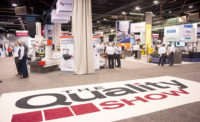Machine vision products such as Nikon's DN100 camera or National Instruments' digital image acquisition software link engineers that are traveling off-site to the factory floor for viewing of a manufactured part or a process. Simultaneous viewing by people in different locations can speed decision making. Clients can also see images of parts for their approval.
"Whole factories can be wired with video cameras," says Stan Schwartz, department manager for Nikon Instruments Inc. (Melville, NY). "Engineers can punch up these images, and with Internet availability, they can view them remotely."
The systems can also be used for automated processes, says Jason Mulliner, vision product manager for National Instruments Corp. (Austin, TX). For example, cameras installed on the assembly line of an engine block manufacturer can capture the image as the engine block passes. Software can then gage the distances between parts or points on parts and analyze them against known data.
"The cost of PC-based vision is more affordable, and people are deploying it more and more inside the plant," says Mulliner. "We see a market trend where companies do more inline inspection because they can place three or four of these cameras along the manufacturing line and inspect it at different stages."
Micro or Macro
Nikon's DN100 can capture images either with a microscope or a camera. The DN100 takes monocrhome 1.3 mega-pixel images, or 3.6 megapixels color images, at a rate of 15 frames per second. The captured images can be transferred to networked parties simultaneously at rates as fast as one frame every two seconds up through one frame every 10 minutes for time-lapse applications. These speeds depend on the transfer rate at the receiving computer.
The operator can control the camera and have it zoom in or out. Comparing products against a sample can be done in a dual-image split screen model. To determine the exact size of the part, a scale bar references the object's size.
Image resolution can be as high as 1,280 by 1,040 in SXGA mode, and the remote user can direct the camera to select the image resolution. "The resolution that the camera would send to the remote area could vary from 320 by 240 images all the way up to 1,280 by 1,040," says Schwartz. "The resolution is selectable by the user at the remote site. So he could have a very high resolution, 3.6 megabyte image delivered to him."
The DN100 has an embedded processor and therefore it is not platform dependent. The camera, which sells for about $4,000, attaches directly to a local area network or the Internet and can be accessed through standard browser communication programs such as Internet Explorer or Netscape.
Users also have the option of directly storing images on the PCMCIA type II card slot with a compact flash card or memory stick. Databases can be created and images can be downloaded to an FTP server for distribution, printing or creating a database. The images can be analyzed using third party statistical software.
Laptop image viewing
National Instruments' NI-IMAQ driver software allows images taken with an IEEE 1394-compatible camera to be transferred to a laptop or standalone computer.
Engineers can use the NI-IMAQ for IEEE 1394 cameras for color image acquisition at 30 frames per second up to 640 by 480 resolution. For applications that require higher resolutions and frame rates, National Instruments offers digital image acquisition boards such as the PCI-1409 that can acquire images in 8- or 10-bit mode at rates as high as 60 frames per second using a double-speed progressive-scan camera. The NI-IMAQ software ships free with the PCI-1409 board, which starts at $1,195.
The NI-IMAQ software driver alone goes for about $595. The package has a set of VIs and C functions that can be used to create measurement programs. It can determine color and also has a built-in measurement and automation utility. "It looks like a Windows Explorer window and it allows you to see all the measurement devices that are on the machine. In one interface, you can see all of these measurement devices and configure them and test them," says Mulliner. Users can integrate other software packages to the Windows-based NI-IMAQ. Statistical process control programs, for instance, can be installed on the same computer as the vision system. "An engineer can see at a glance the yield of the manufacturing process," Mulliner notes.
